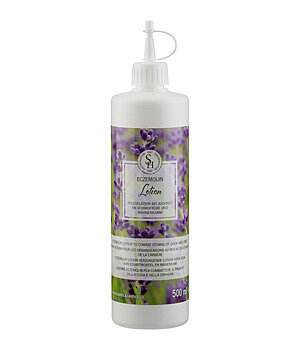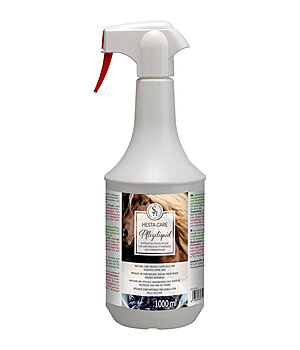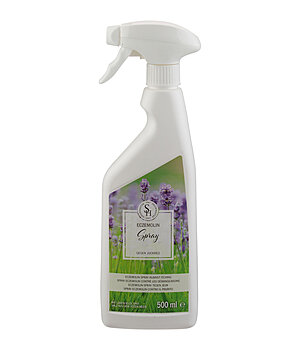Keeping and caring for a horse with sweet itch
As with all horses with sweet itch, keeping a horse with sweet itch is somewhat more complicated than with a healthy horse. In addition to care, there are a number of things to consider in terms of housing, nutrition and pasture management. We explain to you which things there are to consider as an owner of a sweet itch horse:

1. Fly protection
Insect saliva is the trigger for sweet itch. Fly protection is therefore the first priority when keeping a sweet itch horse during the acute phase.
The two most sensible measures are:
- The textile fly protection
For sweet itch sufferers, the use of sweet itch rugs and masks makes sense. In our guide on the subject of horse rugs you will find all the information you need on the subject of sweet itch rugs.
- The use of fly repellents
You can find out which fly repellent is suitable for your horse and what you need to bear in mind when using it in our guide on the subject of fly repellent for horses.
2. Care & hygiene
As the skin of a horse with sweet itch is very stressed in summer, it needs to be cared for in a sustainable way – and this is best done out of season. Horses suffering from sweet itch usually have metabolic problems with their skin and coat throughout the year.
If the sweet itch is already pronounced and accompanied by dandruff, rashes and itching, the affected areas should definitely be treated with specific sweet itch care products. If the areas are even already sore and open, you should also rely on strict hygiene and ointments with an antibacterial effect, which can prevent infection.
SELECTED PRODUCTS FOR SWEET ITCH CARE
Since almost all care products for sweet itch horses contain essential oils, the coat and skin is usually covered with a greasy film. Since grease automatically attracts dust and dirt and these impurities in combination with open wounds form an ideal breeding ground for germs and bacteria, a sweet itch horse or at least the affected areas should be washed off regularly, also to make the skin receptive again for the caring substances.
Horse accessories such as rugs, saddle pads and even grooming equipment should also be cleaned and disinfected regularly, especially if there is direct contact with the sweet itch sores.
3. Nutrition
Since sweet itch is often caused by a metabolic disorder due to nutritional factors, it is important to ensure that the horse is fed a diet that meets its needs throughout the year.
The following advice should be followed for sweet itch sufferers:
- High quality feed to avoid harmful substances that are harmful to the liver.
- Reduce sugar, starch, carbohydrates and proteins.
- Pay attention to feed without additives
- no silage/haylage
- Identify mineral deficiencies and supplement feed if necessary.
You can find out which feed ingredients can have a positive influence on the skin condition under point 1. „What is sweet itch?“ We have summarised further information on targeted nutrition in the fly season in our fly protection guide.
4. Pasture management
During fly season, the greatest imperative when keeping a sweet itch horse is to keep the insect population in the pasture area to a minimum.
This is best achieved by the following measures:
- Regularly muck out the paddock and remove potential breeding places for the insects.
- Regularly replace, cover or dump standing water, as mosquitoes lay their eggs in the water.
- Set up insect traps (for more information, see our guide „Fly protection for the stable“).

As a general rule, you should avoid putting a sweet itch horse in a damp meadow. Insects are magically attracted to moisture and especially if small puddles have formed, these are used as breeding grounds. Pastures that are located near water bodies or moors are also potentially more insect-rich. A forest edge is also more critical for a sweet itch. If you can switch to a pasture that is a little further away from the insect-rich zones mentioned, then you should take advantage of this for the sake of your horse.
Pasture preparation:
There is always a lot to do in preparation for the grazing season. In addition to removing weeds and poisonous plants, you should also maintain the pasture fences and reseed and fertilise the pasture. If a sweet itch sufferer is to be put out to pasture, consideration can already be given to the disease when managing the pasture.
The secret to sweet itch-friendly pasture is a low fructan content. Fructan is a carbohydrate that is mostly deposited in the stem of the plant. The breakdown process of fructan produces gases and toxins that are excreted by the liver and skin. Excess can result in metabolic disorders and a weakened immune system, which can affect the health of the skin and hair in a sweet itch horse.
To keep the fructan content of the paddock as low as possible, the following things can be considered:
- Reseeding: look for low-fructan grasses (these include timothy, red fescue, cocksfoot, meadow foxtail)
- Regular fertilising: reduces the fructan content.
The construction of pasture fences should also be sweet itch-friendly: Wooden fences are welcome rubbing opportunities for the itchy horse. Electric fencing is best for sweet itch sufferers, as are fences made of smooth materials such as metal, which the horse cannot chafe against.
Grazing:
The start of the grazing season is associated with an enormous change in feed for the horse. The high protein and fructan content of the pasture is a challenge even for the metabolism of healthy horses. Since the protein and fructan content of the grass is very high, especially in spring, and horses with sweet itch react extremely sensitively to it, getting used to grazing must be done carefully.
We have some tips for you on how to get used to grazing smoothly:
- Feed hay before grazing (this reduces ravenous hunger and the horse does not eat so greedily).
- Avoid concentrates immediately before and after grazing!
- When temperatures rise, the fructan content decreases; when temperatures fall, the fructan content increases. The fructan content is particularly high in spring and autumn when it is cold at night and warm and sunny during the day. On such days, grazing should be avoided or limited in time.
- It is best to start in the afternoon, when the fructan content is lower than in the morning.
- Start with 10-15 minutes of grazing (also controlled in hand!) and increase by 15 minutes every second to fourth day.
- From the second week on, let the horses graze for one hour in the morning and one hour in the evening, increase by half an hour every second day.
- Caution! If the grazing of the horse is interrupted, e.g. by an injury or illness, it is essential to start again from the beginning!
- Keep a close eye on the horse! (Be careful if the horse’s legs are filled or its hooves are warm!)
- Use a grazing muzzle: To prevent the horse from eating too much fructan-rich grass, a grazing muzzle can also limit consumption.
5. Keeping
A species-appropriate way of keeping should be made possible for every horse – regardless of whether it is healthy or ill. Of course, it is important to protect a horse with sweet itch from insect bites, but keeping it in a stall permanently is not the right measure. Finally, factors such as lack of exercise and obesity can also be a cause of sweet itch, so it is of great importance for keeping your horse healthy to allow daily grazing while taking appropriate insect protection measures into account. It is important that your horse has the possibility to retreat independently if the insects disturb too much. A dark retreat that can be reached at any time and is additionally provided with strip curtains can provide the horse with moments of peace during the stressful insect season. If this is not possible, the horse should be temporarily taken out of the pasture.











